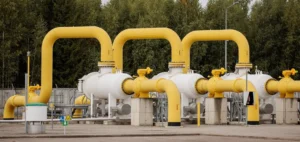The European Union’s sanctions against Russia have reached a new dimension with the 14th package of measures, directly affecting Russian liquefied natural gas (LNG).
Adopted on June 24, 2024, this package includes specific bans on the transshipment of Russian LNG in European ports and the import of LNG via terminals not connected to the EU’s natural gas network.
This initiative aims to reduce Europe’s dependence on Russian gas while exerting economic pressure on Moscow.
An Oxford Energy report details the implications of these sanctions.
Background to sanctions
Since Russia’s invasion of Ukraine in February 2022, the EU has been striving to reduce its energy dependence on Russia.
The REPowerEU plan calls for a series of measures to eliminate Russian gas by 2027.
Pipeline gas imports have already fallen significantly, from 142 billion cubic meters (bcm) in 2021 to 26 bcm in 2023.
However, Russian LNG imports have risen slightly, reaching 20.7 bcm in 2023, despite a year-on-year decline.
Specific measures and their implications
The new sanctions include a ban on the transshipment of Russian LNG in EU ports, a ban on importing Russian LNG via terminals not connected to the EU natural gas grid, and a ban on supplying goods, technologies or services for the realization of LNG projects in Russia.
These measures are intended to logically and legally complicate operations for market players, without significantly reducing the availability of Russian LNG in Europe.
Sanctions on LNG transshipment, in particular, will affect operations in ports such as Zeebrugge and Montoir-de-Bretagne, where a large proportion of Russian LNG is currently transshipped.
This could force Russian exporters to seek alternatives, such as transshipments on the high seas or via non-European ports, thereby increasing logistics costs.
Impact on LNG contracts
LNG supply contracts, particularly those involving transshipments in the EU, will have to be revised.
The main contractors, such as TotalEnergies, SEFE and CNPC, will have to find solutions to continue honoring their commitments.
For example, CNPC, which imports Russian LNG into China, may have to adjust its delivery routes and schedules, thereby increasing transport costs and lead times.
Transshipment contracts, such as the 20-year contract between Fluxys and Yamal Trade, will be particularly affected.
Terminal operators could invoke force majeure to suspend their obligations without incurring penalties.
However, this approach could be contested, potentially leading to international arbitration.
Alternatives and adaptations
With bans in place, Russian LNG ferries will have to consider alternatives.
The Russian port of Murmansk and the Northern Sea Route are viable options, though logically more costly and complex.
These alternatives would increase transport costs and environmental risks, particularly in winter when icebreakers are needed to escort the vessels.
Sanctions will also affect small off-grid terminals in Sweden and Finland.
These terminals, which currently receive LNG from Vysotsk, will have to find new sources of supply, while Novatek will have to redirect its cargoes to other European destinations.
Perspectives and conclusions
EU sanctions on Russian LNG demonstrate Europe’s determination to reduce its energy dependence on Russia.
While these measures create logistical and legal challenges for market players, they could paradoxically increase the availability of Russian LNG in Europe, if Russian exporters redirect cargoes originally destined for Asia to European customers.
The ban on services and technologies for LNG projects in Russia is intended to delay or make more costly the commissioning of new projects such as Arctic LNG 2.
However, the scope of this ban remains unclear and will depend on the ability of Russian companies to find alternative suppliers.
In short, these sanctions represent a balancing act on the part of the EU, seeking to weaken the Russian economy while minimizing the impact on European energy security.
Companies and governments will need to navigate these new regulations carefully to maintain energy market stability.





















